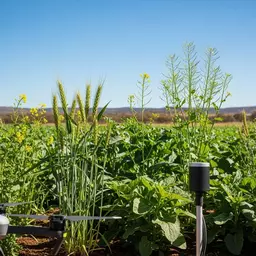CRISPR-Cas9
- ✓ Cost-Effectiveness: Generally more affordable.
- ✓ Simplicity: More straightforward execution.
- ✓ Versatility: Flexible for diverse applications.
The integration of CRISPR technology into Australian agriculture is reshaping the future of crop breeding, addressing pressing challenges such as climate change and food security. What innovative solutions can we expect as we harness the power of gene editing?
This visual highlights the key advantages of CRISPR technology compared to other gene-editing methods in agricultural applications.
In recent years, the agricultural landscape in Australia has been transformed by advancements in technology. One of the most revolutionary breakthroughs has been the development of CRISPR, a powerful tool that enables precise gene editing. With its ability to enhance crop traits, CRISPR is paving the way for a more sustainable agricultural future. But what exactly does this mean for our farmers and ecosystems?
As we explore the impact of CRISPR on crop breeding, it's essential to understand the underlying mechanisms that make this technology so effective. By leveraging CRISPR-Cas9 technology, scientists can target specific genes in plants, effectively altering their DNA to promote desirable traits. This precision allows for modifications that traditional breeding techniques cannot achieve.
CRISPR-Cas9 is a revolutionary gene-editing tool that has been a game-changer in various fields, especially agriculture. At its core, it allows scientists to cut DNA at specific locations, enabling them to add, remove, or alter genetic material. This process harnesses a natural defense mechanism found in bacteria, making it an efficient and precise method for genetic modification.
Here’s how CRISPR works in a nutshell:
This simple yet effective method can lead to significant advancements in crop breeding, allowing us to tackle challenges such as climate change and food security head-on.
Gene editing technologies like CRISPR play a crucial role in enhancing agricultural productivity. By streamlining the breeding process, we can develop crops that are not only more resilient but also more nutritious. Innovations in biotechnology are reshaping how we approach food production, contributing to a sustainable future. For more insights into the regulatory environment and ongoing research in Australia, you can explore resources like the CRISPR-Gene Editing Regs Tracker, which provides valuable information on crop and food regulations.
Some key benefits of gene editing in agriculture include:
At Plant Frontier Insights, we believe that understanding and adopting these technologies is vital for ensuring the resilience of Australia’s agricultural systems.
Given the unpredictable climate conditions we face today, enhancing drought tolerance in crops has never been more critical. CRISPR is being utilized to develop plants that can withstand prolonged dry spells while maintaining productivity. This is not just about survival—it's about ensuring food security for future generations. For a deeper dive into how gene editing contributes to plant resilience under climate change, you can refer to academic studies such as those published in AoB PLANTS.
For example, researchers are focusing on key genes associated with water-use efficiency, allowing for the development of crops that require less water while still thriving under drought conditions. This progress is essential for farmers across Australia who face the challenges of a changing climate.
Pest management is another area where CRISPR shows great promise. By editing plant genomes, scientists can create varieties that are less susceptible to pests, reducing the need for chemical pesticides. Not only does this enhance crop health, but it also contributes to a more sustainable agricultural approach.
Some benefits of using CRISPR for pest resistance include:
Through innovative applications of CRISPR technology, we can foster a more resilient agricultural sector that meets the needs of both farmers and consumers.
How do you view the role of CRISPR in shaping the future of Australian agriculture? Share your thoughts below:
A1: CRISPR-Cas9 is a gene-editing tool that allows scientists to precisely cut DNA at specific locations in plant genomes. In agriculture, it's used to add, remove, or alter genetic material to enhance desirable crop traits, such as drought tolerance and pest resistance.
A2: CRISPR benefits Australian farmers by developing crops that are more resilient to environmental challenges like drought and pests. This can lead to improved crop yields, reduced reliance on chemical pesticides, and lower production costs, ultimately contributing to food security and a more sustainable agricultural sector.
A3: The ethical considerations of CRISPR technology are a significant area of discussion. While it offers immense potential for agricultural improvement, discussions revolve around equity in access, long-term environmental impacts, and transparency with the public. Stakeholder engagement and responsible innovation are crucial.
A4: Compared to other techniques like TALENs and ZFNs, CRISPR is generally more cost-effective, simpler to execute, and more versatile. Its precision and efficiency make it a preferred choice for many agricultural applications.
A5: AI and bioinformatics are becoming increasingly important in accelerating gene-editing innovations. They help streamline the process by predicting gene function, analyzing experimental data faster, and facilitating the development of more precise tools, thereby minimizing off-target effects.
As we peer into the future of CRISPR technology in Australian agriculture, it’s clear that exciting developments are on the horizon. Innovations in gene editing hold the promise of addressing some of our most pressing agricultural challenges. By staying at the forefront of these advancements, we at Plant Frontier Insights are committed to fostering conversations that pave the way for a resilient agricultural sector.
In this section, we will explore emerging trends, the integration of new technologies, and the ethical considerations that will shape the future of CRISPR in our food systems.
The landscape of gene editing is evolving rapidly, with various techniques emerging alongside CRISPR. Understanding these trends is essential for researchers, farmers, and policymakers alike. Here are some important aspects to consider:
By embracing these emerging trends, we can not only enhance crop resilience but also fine-tune our approaches to food production in an ever-changing environment.
Understanding the differences between CRISPR and other genome editing technologies helps to highlight its unique benefits. Here’s a look at how CRISPR stands out:
As we look forward, the continuous refinement of these technologies will be crucial in driving agricultural innovation.
The future of CRISPR also hinges on advancements in AI and bioinformatics. These technologies can streamline the gene editing process by:
By harnessing the power of AI, we can unlock new possibilities in gene editing that promise to revolutionize agricultural practices.
While the potential of CRISPR is immense, we must also navigate the ethical landscape that accompanies such powerful technologies. Addressing socioeconomic implications and ethical concerns is vital for fostering trust and ensuring sustainable practices. For example, a GMO Environmental Scan provides a comprehensive overview of the regulatory and public perception surrounding genetically modified organisms, including those developed using CRISPR.
At Plant Frontier Insights, we believe in the importance of engaging various stakeholders in dialogues about biotechnology. This collaborative approach will help us strike a balance between innovation and responsibility.
As we advance with gene editing, several ethical considerations arise:
By addressing these issues, we can foster an environment where innovation occurs responsibly and ethically.
Engagement is key to navigating the future of CRISPR in agriculture. By collaborating with:
We can create a framework for sustainable agricultural practices that leverage the full potential of CRISPR technology. Together, we can forge a path toward a resilient agricultural future.
Here is a quick recap of the important points discussed in the article:

 As the agricultural landscape in Australia evolves, the role of genetic innovation tools becomes inc
As the agricultural landscape in Australia evolves, the role of genetic innovation tools becomes inc
 As the agricultural landscape in Australia faces mounting challenges, understanding effective crop p
As the agricultural landscape in Australia faces mounting challenges, understanding effective crop p
 As Australia faces growing agricultural challenges, the significance of biosecurity cannot be overst
As Australia faces growing agricultural challenges, the significance of biosecurity cannot be overst
 As we delve into the intricate world of biosecurity, consider this: the health of Australia’s ecos
As we delve into the intricate world of biosecurity, consider this: the health of Australia’s ecos